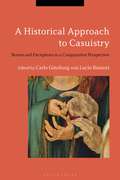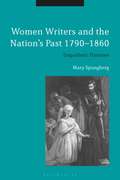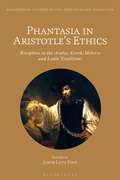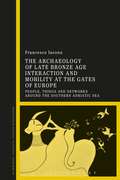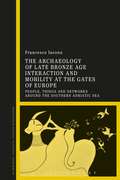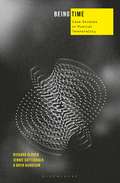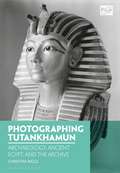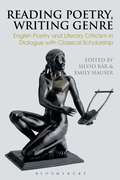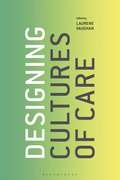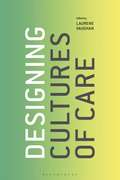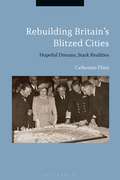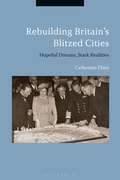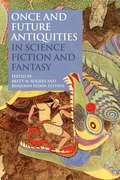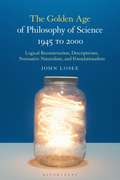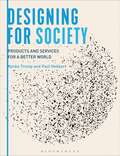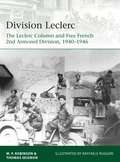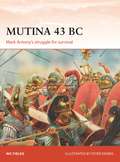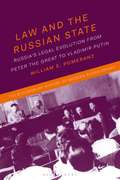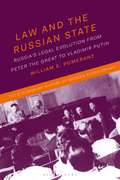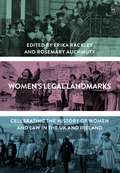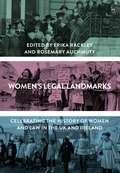- Table View
- List View
A Historical Approach to Casuistry: Norms and Exceptions in a Comparative Perspective
by Carlo Ginzburg Lucio BiasioriCasuistry, the practice of resolving moral problems by applying a logical framework, has had a much larger historical presence before and since it was given a name in the Renaissance. The contributors to this volume examine a series of case studies to explain how different cultures and religions, past and present, have wrestled with morality's exceptions and margins and the norms with which they break. For example, to what extent have the Islamic and Judaic traditions allowed smoking tobacco or gambling? How did the Spanish colonization of America generate formal justifications for what it claimed? Where were the lines of transgression around food, money-lending, and sex in Ancient Greece and Rome? How have different systems dealt with suicide?Casuistry lives at the heart of such questions, in the tension between norms and exceptions, between what seems forbidden but is not. A Historical Approach to Casuistry does not only examine this tension, but re-frames casuistry as a global phenomenon that has informed ethical and religious traditions for millennia, and that continues to influence our lives today.
Women Writers and the Nation's Past 1790-1860: Empathetic Histories
by Prof Mary Spongberg1790 saw the publication of Edmund Burke's Reflections on the Revolution in France -- the definitive tract of modern conservatism as a political philosophy. Though women of the period wrote texts that clearly responded to and reacted against Burke's conception of English history and to the contemporary political events that continued to shape it, this conversation was largely ignored or dismissed, and much of it remains to be reconsidered today.Examining the works of women writers from Jane Austen and Mary Wollstonecraft to the Strickland sisters and Mary Anne Everett Green, this book begins to recuperate that conversation and in doing so uncovers a more complete and nuanced picture of women's participation in the writing of history. Professor Mary Spongberg puts forward an alternate, feminized historiography of Britain that demonstrates how women writers' recourse to history caused them to become generically innovative and allowed them to participate in the political debates that framed the emergence of modern British historiography, and to push back against the Whig interpretation of history that predominated from 1790-1860.
Women Writers and the Nation's Past 1790-1860: Empathetic Histories
by Prof Mary Spongberg1790 saw the publication of Edmund Burke's Reflections on the Revolution in France -- the definitive tract of modern conservatism as a political philosophy. Though women of the period wrote texts that clearly responded to and reacted against Burke's conception of English history and to the contemporary political events that continued to shape it, this conversation was largely ignored or dismissed, and much of it remains to be reconsidered today.Examining the works of women writers from Jane Austen and Mary Wollstonecraft to the Strickland sisters and Mary Anne Everett Green, this book begins to recuperate that conversation and in doing so uncovers a more complete and nuanced picture of women's participation in the writing of history. Professor Mary Spongberg puts forward an alternate, feminized historiography of Britain that demonstrates how women writers' recourse to history caused them to become generically innovative and allowed them to participate in the political debates that framed the emergence of modern British historiography, and to push back against the Whig interpretation of history that predominated from 1790-1860.
Phantasia in Aristotle's Ethics: Reception in the Arabic, Greek, Hebrew and Latin Traditions (Bloomsbury Studies in the Aristotelian Tradition)
by Jakob Leth FinkIn the Nicomachean Ethics, Aristotle suggests that a moral principle 'does not immediately appear to the man who has been corrupted by pleasure or pain'. Phantasia in Aristotle's Ethics investigates his claim and its reception in ancient and medieval Aristotelian traditions, including Arabic, Greek, Hebrew and Latin.While contemporary commentators on the Ethics have overlooked Aristotle's remark, his ancient and medieval interpreters made substantial contributions towards a clarification of the claim's meaning and relevance. Even when the hazards of transmission have left no explicit comments on this particular passage, as is the case in the Arabic tradition, medieval responders still offer valuable interpretations of phantasia (appearance) and its role in ethical deliberation and action. This volume casts light on these readings, showing how the distant voices from the medieval Arabic, Greek, Hebrew and Latin Aristotelian traditions still contribute to contemporary debate concerning phantasia, motivation and deliberation in Aristotle's Ethics.
The Archaeology of Late Bronze Age Interaction and Mobility at the Gates of Europe: People, Things and Networks around the Southern Adriatic Sea
by Dr Francesco IaconoInteraction and mobility have attracted much interest in research within scholarly fields as different as archaeology, history, and more broadly the humanities. Critically assessing some of the most widespread views on interaction and its social impact, this book proposes an innovative perspective which combines radical social theory and currently burgeoning network methodologies.Through an in-depth analysis of a wealth of data often difficult to access, and illustrated by many diagrams and maps, the book highlights connections and their social implications at different scales ranging from the individual settlement to the Mediterranean. The resulting diachronic narrative explores social and economic trajectories over some seven centuries and sheds new light on the broad historical trends affecting the life of people living around the Middle Sea. The Bronze Age is the first period of intense interaction between early state societies of the Eastern Mediterranean and the small-scale communities to the west of Greece, with people and goods moving at a scale previously unprecedented. This encounter is explored from the vantage point of one of its main foci: Apulia, located in the southern Adriatic, at the junction between East and West and the entryway of one of the major routes for the resource-rich European continent.
The Archaeology of Late Bronze Age Interaction and Mobility at the Gates of Europe: People, Things and Networks around the Southern Adriatic Sea
by Dr Francesco IaconoInteraction and mobility have attracted much interest in research within scholarly fields as different as archaeology, history, and more broadly the humanities. Critically assessing some of the most widespread views on interaction and its social impact, this book proposes an innovative perspective which combines radical social theory and currently burgeoning network methodologies.Through an in-depth analysis of a wealth of data often difficult to access, and illustrated by many diagrams and maps, the book highlights connections and their social implications at different scales ranging from the individual settlement to the Mediterranean. The resulting diachronic narrative explores social and economic trajectories over some seven centuries and sheds new light on the broad historical trends affecting the life of people living around the Middle Sea. The Bronze Age is the first period of intense interaction between early state societies of the Eastern Mediterranean and the small-scale communities to the west of Greece, with people and goods moving at a scale previously unprecedented. This encounter is explored from the vantage point of one of its main foci: Apulia, located in the southern Adriatic, at the junction between East and West and the entryway of one of the major routes for the resource-rich European continent.
Being Time: Case Studies in Musical Temporality
by Jennie Gottschalk Richard Glover Bryn HarrisonBeing Time invites a deep consideration of the personal experience of temporality in music, focusing on the perceptual role of the listener. Through individual case studies, this book centers on musical works that deal with time in radical ways. These include pieces by Morton Feldman, James Saunders, Chiyoko Szlavnics, Ryoji Ikeda, Toshiya Tsunoda, Laurie Spiegel and André O. Möller. Multiple perspectives are explored through a series of encounters, initially between an individual and a work, and subsequently with each author's varying experiences of temporality. The authors compare their responses to features such as repetition, speed, duration and scale from a perceptual standpoint, drawing in reflections on aspects such as musical memory and anticipation. The observations made in this book are accessible and relevant to readers who are interested in exploring issues of temporality from a broad range of disciplinary perspectives.
Photographing Tutankhamun: Archaeology, Ancient Egypt, and the Archive (Photography, History: History, Photography)
by Dr Christina RiggsThey are among the most famous and compelling photographs ever made in archaeology: Howard Carter kneeling before the burial shrines of Tutankhamun; life-size statues of the boy king on guard beside a doorway, tantalizingly sealed, in his tomb; or a solid gold coffin still draped with flowers cut more than 3,300 years ago. Yet until now, no study has explored the ways in which photography helped mythologize the tomb of Tutankhamun, nor the role photography played in shaping archaeological methods and interpretations, both in and beyond the field. This book undertakes the first critical analysis of the photographic archive formed during the ten-year clearance of the tomb, and in doing so explores the interface between photography and archaeology at a pivotal time for both. Photographing Tutankhamun foregrounds photography as a material, technical, and social process in early 20th-century archaeology, in order to question how the photograph made and remade 'ancient Egypt' in the waning age of colonial order.
Reading Poetry, Writing Genre: English Poetry and Literary Criticism in Dialogue with Classical Scholarship (Bloomsbury Studies in Classical Reception)
by Silvio Bär Emily HauserThis ground-breaking volume connects the situatedness of genre in English poetry with developments in classical scholarship, exploring how an emphasis on the interaction between English literary criticism and Classics changes, sharpens, or perhaps even obstructs views on genre in English poetry. “Genre” has classical roots: both in the etymology of the word and in the history of genre criticism, which begins with Aristotle. In a similar vein, recent developments in genre studies have suggested that literary genres are not given or fixed entities, but subjective and unstable (as well as historically situated), and that the reception of genre by both writers and scholars feeds back into the way genre is articulated in specific literary works.Classical scholarship, literary criticism, and genre form a triangle of key concepts for the volume, approached in different ways and with different productive results by contributors from across the disciplines of Classics and English literature. Covering topics from the establishment of genre in the Middle Ages to the invention of female epic and the epyllion, and bringing together the works of English poets from Milton to Tennyson to Josephine Balmer, the essays collected hereargue that the reception and criticism of classical texts play a crucial part in generic formation in English poetry.
Designing Cultures of Care
by Laurene VaughanDesigning Cultures of Care brings together an international selection of design researchers who, through a variety of design approaches, are exploring the ways in which design intersects with cultures of care. Unique in its focus and disciplinary diversity, this edited collection develops an expanded discourse on the role and contribution of design to our broader social, cultural and material challenges. Based around a unifying critique of the proposition of care as a theoretical framework for undertaking design research in real worldcontexts, each chapter presents a case study of design research in action.This book aims to provide readers - both academics and practitioners - with insights into the possibilities and challenges of designing cultures of care. The disciplines represented in this collection include architecture, visual communication, participatory and social design, service design, critical and speculative design interventions and design ethnography. These case studies will provide real world insights that have relevance and value to design students at both undergraduate and postgraduate levels, and to researchers at all levels within and outside of the academy.
Designing Cultures of Care
by Laurene VaughanDesigning Cultures of Care brings together an international selection of design researchers who, through a variety of design approaches, are exploring the ways in which design intersects with cultures of care. Unique in its focus and disciplinary diversity, this edited collection develops an expanded discourse on the role and contribution of design to our broader social, cultural and material challenges. Based around a unifying critique of the proposition of care as a theoretical framework for undertaking design research in real worldcontexts, each chapter presents a case study of design research in action.This book aims to provide readers - both academics and practitioners - with insights into the possibilities and challenges of designing cultures of care. The disciplines represented in this collection include architecture, visual communication, participatory and social design, service design, critical and speculative design interventions and design ethnography. These case studies will provide real world insights that have relevance and value to design students at both undergraduate and postgraduate levels, and to researchers at all levels within and outside of the academy.
Rebuilding Britain's Blitzed Cities: Hopeful Dreams, Stark Realities
by Catherine FlinnMany British cities were devastated by bombing during the Second World War and faced stark economic dilemmas concerning reconstruction planning and implementation after 1945. How did politicians, civil servants and local authorities manage to produce the cities we live in today? Rebuilding Britain's Blitzed Cities examines the underlying processes and pressures, especially financial and bureaucratic, which shaped postwar urbanism in Britain.Catherine Flinn integrates architectural planning with in-depth economic and political analyses of Britain's blitzed cities for the first time. She examines early reconstruction arrangements, the postwar economic apparatus and the challenges of postwar physical planning across the country, while providing insightful case studies from the cities of Hull, Exeter and Liverpool.By addressing the ideology versus the reality of reconstruction in postwar Britain, Rebuilding Britain's Blitzed Cities highlights the importance of economic and political factors for understanding the British postwar built environment.
Rebuilding Britain's Blitzed Cities: Hopeful Dreams, Stark Realities
by Catherine FlinnMany British cities were devastated by bombing during the Second World War and faced stark economic dilemmas concerning reconstruction planning and implementation after 1945. How did politicians, civil servants and local authorities manage to produce the cities we live in today? Rebuilding Britain's Blitzed Cities examines the underlying processes and pressures, especially financial and bureaucratic, which shaped postwar urbanism in Britain.Catherine Flinn integrates architectural planning with in-depth economic and political analyses of Britain's blitzed cities for the first time. She examines early reconstruction arrangements, the postwar economic apparatus and the challenges of postwar physical planning across the country, while providing insightful case studies from the cities of Hull, Exeter and Liverpool.By addressing the ideology versus the reality of reconstruction in postwar Britain, Rebuilding Britain's Blitzed Cities highlights the importance of economic and political factors for understanding the British postwar built environment.
Once and Future Antiquities in Science Fiction and Fantasy (Bloomsbury Studies in Classical Reception)
by Brett M. Rogers Benjamin Eldon StevensIn 15 all-new essays, this volume explores how science fiction and fantasy draw on materials from ancient Greece and Rome, 'displacing' them from their original settings-in time and space, in points of origins and genre-and encouraging readers to consider similar 'displacements' in the modern world. Modern examples from a wide range of media and genres-including Philip Pullman's His Dark Materials and the novels of Helen Oyeyemi, the Rocky Horror Picture Show and Hayao Miyazaki's Spirited Away, and the role-playing games Dungeons and Dragons and Warhammer 40K-are brought alongside episodes from ancient myth, important moments from history, and more. All together, these multifaceted studies add to our understanding of how science fiction and fantasy form important areas of classical reception, not only transmitting but also transmuting images of antiquity. The volume concludes with an inspiring personal reflection from the New York Times-bestselling author of speculative fiction, Catherynne M. Valente, offering her perspective on the limitless potential of the classical world to resonate with experience today.
Once and Future Antiquities in Science Fiction and Fantasy (Bloomsbury Studies in Classical Reception)
by Brett M. Rogers Benjamin Eldon StevensIn 15 all-new essays, this volume explores how science fiction and fantasy draw on materials from ancient Greece and Rome, 'displacing' them from their original settings-in time and space, in points of origins and genre-and encouraging readers to consider similar 'displacements' in the modern world. Modern examples from a wide range of media and genres-including Philip Pullman's His Dark Materials and the novels of Helen Oyeyemi, the Rocky Horror Picture Show and Hayao Miyazaki's Spirited Away, and the role-playing games Dungeons and Dragons and Warhammer 40K-are brought alongside episodes from ancient myth, important moments from history, and more. All together, these multifaceted studies add to our understanding of how science fiction and fantasy form important areas of classical reception, not only transmitting but also transmuting images of antiquity. The volume concludes with an inspiring personal reflection from the New York Times-bestselling author of speculative fiction, Catherynne M. Valente, offering her perspective on the limitless potential of the classical world to resonate with experience today.
The Golden Age of Philosophy of Science 1945 to 2000: Logical Reconstructionism, Descriptivism, Normative Naturalism, and Foundationalism
by John LoseeThis book offers the reader a guide to the major philosophical approaches to science since World War Two. Considering the bases, arguments and conclusions of the four main movements – Logical Reconstructionism, Descriptivism, Normative Naturalism and Foundationalism – John Losee explores how philosophy has both shaped and expanded our understanding of science. The volume features major figures of twentieth century science, and engages with the work of previous philosophers of science, including Norman Campbell, Rudolf Carnap, Ernest Nagel, Karl Popper, Richard Dawkins, and John Worrall. In particular, The Golden Age of Philosophy of Science, 1945 to 2000 aims to answer the following questions: How should competing philosophies of science be evaluated? Should philosophy of science be a prescriptive discipline? Can philosophy of science achieve normative status without designating trans-historical evaluative principles? And finally, how can understanding the history of science aid us in analyzing the philosophy of science? In answering these questions, this book shows us why we understand science the way we do. The Golden Age of Philosophy of Science 1945 to 2000 is essential reading for students and researchers working in the history and philosophy of science.
Designing for Society: Products and Services for a Better World
by Nynke Tromp Paul HekkertOur globalised world is encountering problems on an unprecedented scale. Many of the issues we face as societies extend beyond the borders of our nations. Phenomena such as terrorism, climate change, immigration, cybercrime and poverty can no longer be understood without considering the complex socio-technical systems that support our way of living. It is widely acknowledged that to contend with any of the pressing issues of our time, we have to substantially adapt our lifestyles. To adequately counteract the problems of our time, we need interventions that help us actually adopt the behaviours that lead us toward a more sustainable and ethically just future. In Designing for Society, Paul Hekkert and Nynke Tromp provide a hands-on tool for design professionals and students who wish to use design to counteract social issues. Viewing the artefact as a unique means of facilitating behavioural change to realise social impact, this book goes beyond the current trend of applying design thinking to enhancing public services, and beyond the idea of the designer as a facilitator of localised social change.
Designing for Society: Products and Services for a Better World
by Nynke Tromp Paul HekkertOur globalised world is encountering problems on an unprecedented scale. Many of the issues we face as societies extend beyond the borders of our nations. Phenomena such as terrorism, climate change, immigration, cybercrime and poverty can no longer be understood without considering the complex socio-technical systems that support our way of living. It is widely acknowledged that to contend with any of the pressing issues of our time, we have to substantially adapt our lifestyles. To adequately counteract the problems of our time, we need interventions that help us actually adopt the behaviours that lead us toward a more sustainable and ethically just future. In Designing for Society, Paul Hekkert and Nynke Tromp provide a hands-on tool for design professionals and students who wish to use design to counteract social issues. Viewing the artefact as a unique means of facilitating behavioural change to realise social impact, this book goes beyond the current trend of applying design thinking to enhancing public services, and beyond the idea of the designer as a facilitator of localised social change.
Division Leclerc: The Leclerc Column and Free French 2nd Armored Division, 1940–1946 (Elite)
by Raffaele Ruggeri Merlin Robinson Thomas Seignon'General Leclerc' was the nom de guerre adopted by the Gaullist officer Philippe de Hautcloque, to protect his family in occupied France. He became France's foremost fighting commander, and his armored division (the '2e DB') its most famous formation. Starting as a small scratch force of mostly African troops organised and led by Leclerc in French Equatorial Africa, it achieved early success raiding Italian and German positions in co-operation with Britain's Long Range Desert Group. Following the Allied victory in North Africa it was expanded and reorganised as a US Army-style armoured division, with American tanks and other armoured vehicles. Shipped to the UK, in spring 1944, it was assigned to Patton's US Third Army, landing in time for the Normandy breakout and being given the honour of liberating Paris in August 1944. Combining a thorough analysis of their combat and organisation with detailed colour plates of their uniforms and equipment, this is the fascinating story of Free France's most effective fighting force.
Mutina 43 BC: Mark Antony's struggle for survival (Campaign)
by Peter Dennis Nic Fields Bounford.com Bounford.com Paul KimeIn the aftermath of the murder of Gaius Julius Caesar, his self-declared successor Mark Antony struggled to hold together his legacy. Following an abortive coup attempt by Caesar's adopted son Octavian, two of Antony's legions declared for him, leading to a renewed outbreak of civil war. Antony moved into northern Italy and invaded the city of Mutina, which was held by Decimus Brutus. There they were quickly sandwiched between the city walls on one side and the newly arrived Senate-backed forces of Octavian on the other.These two heirs of Caesar then fought to claim their former mentor's legacy. Fully illustrated with specially commissioned artwork and maps, this is the full story of the battles which would see Octavian move from being a young, inexperienced aristocrat to the dominating figure of Augustus.
Law and the Russian State: Russia’s Legal Evolution from Peter the Great to Vladimir Putin (The Bloomsbury History of Modern Russia Series)
by William PomeranzRussia is often portrayed as a regressive, even lawless country, and yet the Russian state has played a major role in shaping and experimenting with law as an instrument of power. In Law and the Russian State, William E. Pomeranz examines Russia's legal evolution from Peter the Great to Vladimir Putin, addressing the continuities and disruptions of Russian law during the imperial, Soviet, and post-Soviet periods along the way. The book covers key themes, including:* Law and empire* Law and modernization* The politicization of law* The role of intellectuals and dissidents in mobilizing the law* The evolution of Russian legal institutions* The struggle for human rights * The rule-of-law* The quest to establish the law-based stateIt also analyzes legal culture and how Russians understand and use the law. Including a useful glossary and a detailed bibliography, this is an important text for anyone seeking a sophisticated understanding of how Russian society and the Russian state have developed in the last 350 years.
Law and the Russian State: Russia’s Legal Evolution from Peter the Great to Vladimir Putin (The Bloomsbury History of Modern Russia Series)
by Dr William PomeranzRussia is often portrayed as a regressive, even lawless country, and yet the Russian state has played a major role in shaping and experimenting with law as an instrument of power. In Law and the Russian State, William E. Pomeranz examines Russia's legal evolution from Peter the Great to Vladimir Putin, addressing the continuities and disruptions of Russian law during the imperial, Soviet, and post-Soviet. The book covers key themes, including:* Law and empire* Law and modernization* The politicization of law* The role of intellectuals and dissidents in mobilizing the law* The evolution of Russian legal institutions* The struggle for human rights * The rule-of-law* The quest to establish the law-based stateIt also analyzes legal culture and how Russians understand and use the law. With a detailed bibliography, this is an important text for anyone seeking a sophisticated understanding of how Russian society and the Russian state have developed in the last 350 years.
Women's Legal Landmarks: Celebrating the history of women and law in the UK and Ireland
by Erika Rackley Rosemary AuchmutyWomen's Legal Landmarks commemorates the centenary of women's admission in 1919 to the legal profession in the UK and Ireland by identifying key legal landmarks in women's legal history. Over 80 authors write about landmarks that represent a significant achievement or turning point in women's engagement with law and law reform. The landmarks cover a wide range of topics, including matrimonial property, the right to vote, prostitution, surrogacy and assisted reproduction, rape, domestic violence, FGM, equal pay, abortion, image-based sexual abuse, and the ordination of women bishops, as well as the life stories of women who were the first to undertake key legal roles and positions. Together the landmarks offer a scholarly intervention in the recovery of women's lost history and in the development of methodology of feminist legal history as well as a demonstration of women's agency and activism in the achievement of law reform and justice.
Women's Legal Landmarks: Celebrating the history of women and law in the UK and Ireland
by Erika Rackley Professor Rosemary AuchmutyWomen's Legal Landmarks commemorates the centenary of women's admission in 1919 to the legal profession in the UK and Ireland by identifying key legal landmarks in women's legal history. Over 80 authors write about landmarks that represent a significant achievement or turning point in women's engagement with law and law reform. The landmarks cover a wide range of topics, including matrimonial property, the right to vote, prostitution, surrogacy and assisted reproduction, rape, domestic violence, FGM, equal pay, abortion, image-based sexual abuse, and the ordination of women bishops, as well as the life stories of women who were the first to undertake key legal roles and positions. Together the landmarks offer a scholarly intervention in the recovery of women's lost history and in the development of methodology of feminist legal history as well as a demonstration of women's agency and activism in the achievement of law reform and justice.
NAUSHADNAMA The Life and Music of Naushad: The Life And Music Of Naushad
by Raju BharatanNaushad is by popular consent the greatest among our film music composers, having been active for 65 years! For twenty years during that period, he ruled the field: from Rattan in 1944, he was the standard against whom every other composer tried to match himself! He didn't have much to show by way of originality after Mughal e Azam (1961), though his music never became base : it was only that the stars for whom he composed declined, the public taste changed, he became trapped in his own image as the custodian of the classical mould in film sangeet. It is a measure of the great man that he steadily refused to succumb to the market pressure. His composing abilities were never in question, but he could not give 'hits" or tunes that would appeal.When he tried to adjust, he was pathetic. Raju Bharatan is such an authority on Naushad and our film music, with so much first hand knowledge and information, a book from him on Naushad is likely to be the last word as an account of his professional life. But this book covers so much more: what the cine music filed was like from inside, how the composers were competing , how they were bad-mouthing Naushad in private, in spite of the show of public bonhomie, what devious games were played to corner awards and limelight, etc. The point is not the filmi world was so dirty; the point is that the composers created great music even in such atmosphere.
